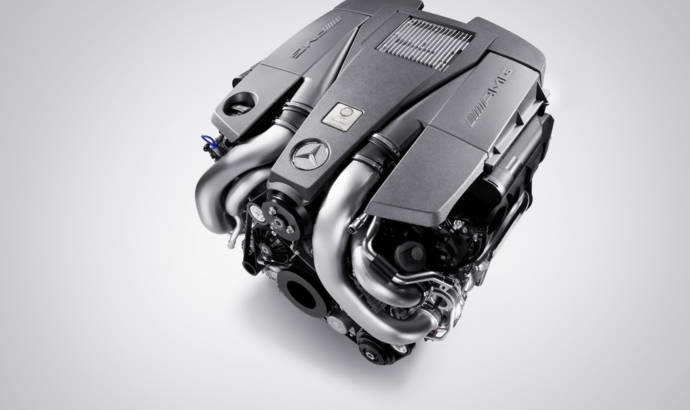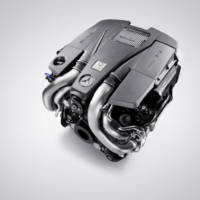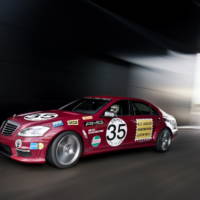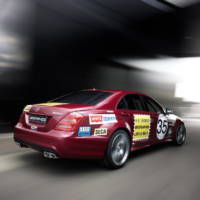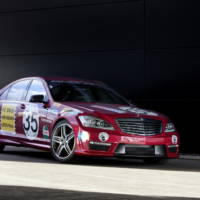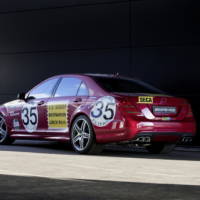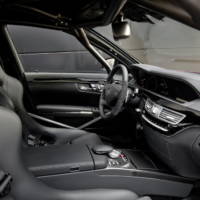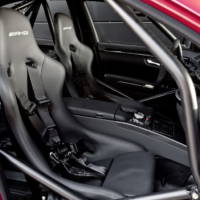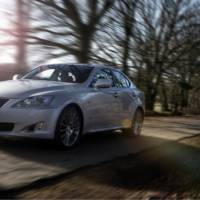Official details and photos with the 2011 Mercedes S63 AMG have been released today by the German manufacturer.
The 2011 Mercedes S63 AMG features a newly developed AMG 5.5-litre V8 biturbo engine that produces 571 horsepower (420 kW) and 900 Nm of torque. So not only it is more powerful but with this engine the 2011 Mercedes S63 AMG needs only 10.5-litres of fuel per 100 Km in a combined cycle, thanks in part to the new AMG SPEEDSHIFT MCT 7-speed sports transmission plus the start/stop function and the "Controlled Efficiency" driving mode.
Performance figures for the 2011 Mercedes S63 AMG indicate that it takes 4.5 seconds for the sports saloon to accelerate from 0 to 100 Km/h while top speed is electronically limited to 250 Km/h. When equipped with the AMG Performance package these figures improve to 4.4 seconds from 0 to 100 Km/h and while the electronically limited top speed raises to 300 Km/h.
The 2011 Mercedes S63 AMG price was not announced yet.
Mercedes press release :
Powerful and efficient: an eight-cylinder developing up to 420 kW (571 hp): Aim: Best in class – top performance in all respects by virtue of a comprehensively efficient powertrain
Affalterbach – AMG is writing another chapter in its "AMG Performance 2015" drive system strategy: a completely newly developed AMG 5.5-litre V8 biturbo engine with a peak output of up to 420 kW (544 to 571 hp) and maximum torque of up to 900 newton metres will enter the lineup in summer 2010. The new eight-cylinder unit known internally as the M 157 impresses with a wealth of technological highlights such as direct petrol injection with spray-guided combustion and twin turbochargers.
This innovative, autonomously developed eight-cylinder power unit from Affalterbach sets new standards in terms of fuel consumption and exemplary efficiency: the new S 63 AMG, in which the V8 biturbo will have its market debut, consumes only 10.5 litres per 100 kilometres (NEDC combined consumption, provisional figure). This represents a saving of 25 percent compared to the current S63 AMG. An intelligently designed power transfer plays a major part in this: the unique AMG SPEEDSHIFT MCT 7-speed sports transmission combines dynamism with economy, and includes a new start/stop function in the "Controlled Efficiency" driving mode. The new engine/transmission combination is the epitome of exclusivity, sophistication, high performance and economy.
The S 63 AMG showcar is a homage to the impressive history of powerful AMG V8 engines: visually this high-performance saloon resembles the spectacular 300 SEL 6.8 AMG, the racing car that won a class victory and second place in the overall ranking for AMG at the 24-hour race in Spa-Francorchamps (Belgium) in 1971 – and made the company world-famous overnight.
"AMG Performance 2015" as the continuation of a success story
Mercedes-AMG is continuing this impressive story with its "AMG Performance 2015" strategy, and meeting its promise to continuously reduce both the fuel consumption and emissions of new models with the new engine/transmission combination – while reaching new heights with the central brand value of "performance".
The new AMG 5.5-litre V8 biturbo engine will play a major part in the Mercedes-AMG model strategy over the next few years. The unique AMG SPEEDSHIFT MCT 7-speed sports transmission will also guarantee a thrilling yet economical power transfer in future AMG high-performance cars. The new engine/transmission combination is another milestone in the success story of Mercedes-AMG, which began in 1967. Another highlight in the company’s more than 40-year history it undoubtedly the SLS AMG: this gull-wing model due to be launched on 27 March 2010 is the first automobile to be completely independently developed by Mercedes-AMG. It means that as the performance brand within Mercedes-Benz Cars, AMG is not only fielding a masterpiece but also demonstrating development expertise at the highest level.
Direct petrol injection with spray-guided combustion and twin turbocharging
Whilst the AMG 6.3 litre V8 naturally aspirated engine has a displacement of 6208 cc the new AMG 5.5-litre V8 biturbo unit makes do with 5461 cc. The use of direct injection technology results in a reduction of exactly 747 cubic centimetres and increases efficiency. For the first time, AMG is also utilising the advantages of direct petrol injection with spray-guided combustion and piezo-electric injectors: thanks to its higher thermodynamic efficiency, this technology makes more efficient use of fuel and leads to lower exhaust emissions. AMG combines this spray-guided combustion with twin turbochargers. Other highlights include a crankcase wholly of aluminium, four-valve technology with adjustable camshafts, an air/water intercooler, generator management and a start/stop function as standard.
This high-tech package leads to a high output and torque yield, together with fuel consumption figures that are unrivalled in the competitive lineup. The AMG 5.5-litre V8 biturbo engine develops a peak output of 400 kW (544 hp) and maximum torque of 800 newton metres. In conjunction with the AMG Performance package these figures are increased to 420 kW (571 hp) and 900 newton metres. A look at the performance diagrams shows that no other engine in this output class achieves the figures delivered by the new AMG biturbo. The major difference between the two performance classes is an increase in the maximum charge pressure from 1.0 to 1.3 bar.
Quantum leap: fuel consumption reduced by 25 percent
With a provisional NEDC fuel consumption of 10.5 litres per 100 kilometres, the new S 63 AMG is 3.9 litres more economical than the preceding model powered by the naturally aspirated AMG 6.3-litre V8 – despite an increase in output by 14 kW (19 hp) resp. 34 kW (46 hp) and in torque by 170 and 270 newton metres. Engine specialists consider this achieved fuel saving of more than 25 percent to be nothing less than a quantum leap. CO2 emissions have likewise been significantly reduced: at 246 grams per kilometre, the figure is 28.5 percent lower than for the previous model.
With figures like these, the new S 63 AMG is not only considerably better than all its competitors, but also more fuel-efficient than much less powerful cars in this segment. Taking into account its enormous performance and torque figures the new AMG 5.5 litre V8 biturbo engine is in parts twice as efficient as many mid-segment or compact-class diesel engines.
At the same time the S 63 AMG delivers superior performance at sports car level: the high-performance saloon accelerates from zero to 100 km/h in 4.5 seconds, and has an electronically limited top speed of 250 km/h. The 100 km/h mark is reached in just 4.4 seconds with the AMG Performance package, with the top speed increased to an electronically limited 300 km/h.
Engine production – tradition of hand-built excellence
Like all other AMG engines, the new eight-cylinder biturbo is assembled by hand in the AMG engine shop taken into commission in 2002. A single, highly-qualified technician assembles the M 157 according to the "one man, one engine" philosophy, maintaining the very strictest quality standards. This painstaking care is attested to by his signature on the characteristic AMG engine plate.
AMG CEO Volker Mornhinweg: "Efficiency plus performance"
"With the new AMG V8 biturbo engine and the AMG SPEEDSHFT MCT 7-speed sports transmission, we are confronting the challenges of the future and focussing on fuel consumption and exhaust emissions even more intensively than before. Our new high-performance engine shows that AMG occupies a leading position in terms of both efficiency and our brand commitment to "performance," says Volker Mornhinweg, Chairman of Mercedes-AMG GmbH.
"The new AMG V8 biturbo engine is yet another milestone in our impressive V8 history. For the first time we have combined spray-guided direct petrol injection with turbocharging. With this high-tech package we are "best in class" with respect to fuel consumption, output and torque," says Friedrich Eichler, Head of Engine and Powertrain Development at Mercedes-AMG.
Key figures at a glance:*
| AMG 5.5-litre V8 biturbo engine | |
| Displacement | 5461 cc |
| Bore x stroke | 98.0 x 90.5 mm |
| Compression ratio | 10.0:1 |
| Output |
400 kW (544 hp) at 5500 rpm 420 kW (571 hp) at 5500 rpm** |
| Max. torque |
800 Nm at 2000-4500 rpm 900 Nm at 2500-3750 rpm** at 2500-3750 rpm* |
| Engine weight (dry) | 204 kg |
| Power/weight ratio |
0.41 kg/hp 0.39 kg/hp** |
* provisional figures; ** with AMG Performance package
Exciting power delivery, characteristic sound
These on-paper figures raise high expectations which the 400 kW (544 hp) AMG 5.5-litre V8 biturbo certainly meets. The flat torque curve ensures enormous pulling power in all speed ranges: 670 newton metres are already available at 1500 rpm, and the maximum torque of 800 newton metres is delivered just 500 rpm later, remaining constant to 4500 rpm. Even more effortless performance is ensured by the engine variant with the AMG Performance package, which has a peak output of 420 kW (571 hp). In this case the eight-cylinder delivers 875 newton metres of torque at just 2000 rpm, with a constant 900 newton metres available between 2500 and 3750 rpm.
It is not only the unrivalled torque delivery of this turbocharged eight-cylinder that makes the heart beat faster, as the agile responsiveness with no irritating charger delay leads to an effortlessness and dynamism previously unknown in this output class. All perfectly matched by the characteristic, sonorous engine note. Moreover, this AMG high-performance engine naturally meets all the requirements with respect to smooth, quiet running and the comfort on long journeys that is to be expected of a Mercedes.
MCT 7-speed sports transmission with Controlled Efficiency mode and start/stop function
Power is transferred by the AMG SPEEDSHIFT MCT 7-speed sports transmission used exclusively by AMG, which is already familiar from the SL 63 AMG and E 63 AMG and combines high emotional appeal with outstanding driving dyna-mics and a high level of efficiency. The wet start-up clutch replaces a conventional torque converter, and helps to save fuel. The exemplary fuel economy is also in large measure due to the standard start/stop function. This system is active in the transmission’s Controlled Efficiency ("C") mode, and switches the eight-cylinder engine off when the car comes to a stop. In "C" mode the sports saloon always starts off in second gear, and the transmission shifts to the next, higher gears at a decidedly early stage. With its high torque at low engine speeds, the V8 engine encourages a smooth, effortless driving style.
The eight-cylinder biturbo engine also features the generator management system familiar from the E 63 AMG: whenever the engine is on the overrun or when braking, kinetic energy is used to charge the battery rather than being wasted as heat in the usual way. In all other operating modes a combination of onboard network and generator management enables the generator to be kept at a low voltage. This reduces the load on the engine and makes for fuel savings of around 0.15 litres per 100 kilometres according to the NEDC standard, and up to 0.2 l/100 km in city traffic with its frequent overrun and braking phases.
Long tradition of powerful AMG V8 engines
Powerful eight-cylinder engines are an integral part of AMG’s history. 2005 saw the debut of the AMG 6.3-litre V8 engine known as the M 156. Depending on the model, this naturally aspirated, high-revving unit develops up to 386 kW (525 hp) and 630 newton metres. Reserved exclusively for the new SLS AMG, the M 159 with the same displacement of 6.3 litres has a peak torque of 420 kW (571 hp) and maximum torque of 650 newton metres. Another milestone in the history of AMG engines was the supercharged AMG 5.5-litre V8 engine introduced in 2001: the M 113 K developed up to 428 kW (582 hp) and 800 newton metres of torque. Even more power was forthcoming from the supercharged AMG 5.5-litre V8 engine of the SLR McLaren dating from 2003 – the M 155 generated up to 478 kW (650 hp) and 820 newton metres.
The supercharged AMG 5.5-litre V8, the AMG 6.3-litre V8 and the AMG 6.0-litre V12 biturbo were all able to win the Best Performance Engine category in the International Engine of the Year Awards.
The first AMG four-valve V8 accelerates "The Hammer" to 303 km/h
Another important engine in the AMG story was the M 117, its first eight-cylinder unit with four-valve technology. With a displacement of 5.6 litres, 265 kW (360 hp) and 510 newton metres of torque, this V8 accelerated the 300 CE 5.6 AMG to a top speed of 303 km/h in 1987. This made the coupé the fastest German car in series production, and American fans reverently christened it "The Hammer".
The S 63 AMG showcar harks back to the historic success in 1971
A historic success was achieved by the 300 SEL 6.8 AMG in 1971: powered by an AMG V8 engine with a displacement of 6.8 litres and developing 315 kW (428 hp), this signal red racing saloon crossed the finishing line in second place during its very first outing at the 24-hour race in Spa-Francorchamps (Belgium), securing victory in its class.
The spectacular S 63 showcar is homage to this triumph, which made AMG world-famous overnight although the company had only been founded in 1967: decorated with sponsoring stickers identical to those on its historic predecessor, this powerful S-Class made by Mercedes-AMG is a sensation. The imposing tyres in size 275/35 R 20 and 325/30 R 20 at the front and rear are just as eye-catching as the 4.5-centimetre wider front wings on each side. The discerning car-lover will even discover exotic wood trim in the style of the original car in the interior. The showcar is powered by the new AMG 5.5-litre V8 biturbo engine and the AMG SPEEDSHIFT MCT 7-speed sports transmission.

